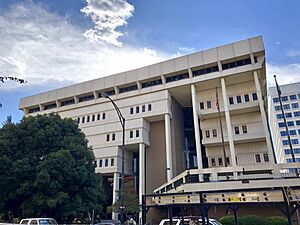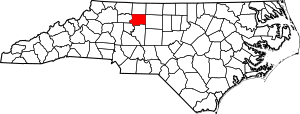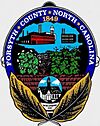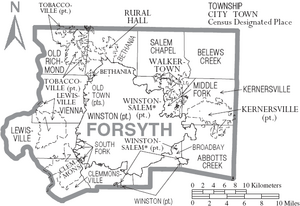Forsyth County, North Carolina facts for kids
Quick facts for kids
Forsyth County
|
|||||
|---|---|---|---|---|---|

Forsyth County Courthouse in Winston-Salem
|
|||||
|
|||||

Location within the U.S. state of North Carolina
|
|||||
 North Carolina's location within the U.S. |
|||||
| Country | |||||
| State | |||||
| Founded | 1849 | ||||
| Named for | Benjamin Forsyth | ||||
| Seat | Winston-Salem | ||||
| Largest community | Winston-Salem | ||||
| Area | |||||
| • Total | 412.35 sq mi (1,068.0 km2) | ||||
| • Land | 407.85 sq mi (1,056.3 km2) | ||||
| • Water | 4.50 sq mi (11.7 km2) 1.09% | ||||
| Population
(2020)
|
|||||
| • Total | 382,590 | ||||
| • Estimate
(2023)
|
392,921 | ||||
| • Density | 937.7/sq mi (362.0/km2) | ||||
| Time zone | UTC−5 (Eastern) | ||||
| • Summer (DST) | UTC−4 (EDT) | ||||
| Congressional districts | 5th, 6th | ||||
Forsyth County is a place in the northwest part of North Carolina, a state in the United States. In 2020, about 382,590 people lived here. This makes it the fourth biggest county in North Carolina by population. Its main city and county seat is Winston-Salem.
Forsyth County is part of a larger area called the Piedmont Triad. This area includes big cities like Greensboro and High Point. Some parts of Forsyth County are also known for growing grapes for wine.
Contents
History of Forsyth County
Forsyth County was created in 1849. It was formed from a nearby area called Stokes County.
The county was named after Colonel Benjamin Forsyth. He was a brave soldier who died in the War of 1812.
Geography of Forsyth County
Forsyth County is located near the Appalachian Mountains. It covers about 412 square miles. Most of this area is land, but about 4.5 square miles is water.
The county has many streams and rivers. The northeast part of the county drains into the Dan River. Most of the county's water flows into the Yadkin River. The Yadkin River also forms the western border of the county.
The lowest point in the county is 660 feet above sea level. This is along the Yadkin River. The highest point is 1100 feet high, near the town of King.
Natural Areas and Parks
Forsyth County has several special places to visit. These include natural areas and historic sites.
- Cascades Preserve (part)
- Emily Allen Wildflower Preserve
- Historic Bethabara Park
- Kaleideum (a museum for kids)
- Old Salem Museums & Gardens (a historic town)
- Shell-Shaped Shell Station (a unique building)
- Tanglewood Park
Rivers and Creeks
Here are some of the main water bodies in Forsyth County:
- Abbotts Creek
- Belews Creek
- Belews Lake
- Beaver Dam Creek
- Brushy Creek
- Blanket Creek
- Buffalo Creek
- Crooked Run Creek
- Lick Creek
- Little Creek
- Little Yadkin River
- Mill Creek
- Muddy Creek
- Old Field Creek
- Reedy Fork
- Salem Creek
- Silas Creek
- South Fork Muddy Creek
- Yadkin River
Neighboring Counties
Forsyth County shares borders with several other counties:
- Stokes County – to the north
- Rockingham County – to the northeast
- Guilford County – to the east
- Davidson County – to the south
- Davie County – to the southwest
- Yadkin County – to the west
- Surry County – to the northwest
Major Roads and Transportation
Many important roads run through Forsyth County. These include major highways that connect to other parts of North Carolina and beyond.
 I-40
I-40


 I-74 / Future I-74
I-74 / Future I-74 US 52
US 52 US 158
US 158 US 421
US 421
The county also has Smith Reynolds Airport. There is also an Amtrak Thruway service in Winston-Salem.
Population and People
| Historical population | |||
|---|---|---|---|
| Census | Pop. | %± | |
| 1850 | 11,168 | — | |
| 1860 | 12,692 | 13.6% | |
| 1870 | 13,050 | 2.8% | |
| 1880 | 18,070 | 38.5% | |
| 1890 | 28,434 | 57.4% | |
| 1900 | 35,261 | 24.0% | |
| 1910 | 47,311 | 34.2% | |
| 1920 | 77,269 | 63.3% | |
| 1930 | 111,681 | 44.5% | |
| 1940 | 126,475 | 13.2% | |
| 1950 | 146,135 | 15.5% | |
| 1960 | 189,428 | 29.6% | |
| 1970 | 214,348 | 13.2% | |
| 1980 | 243,683 | 13.7% | |
| 1990 | 265,878 | 9.1% | |
| 2000 | 306,067 | 15.1% | |
| 2010 | 350,670 | 14.6% | |
| 2020 | 382,590 | 9.1% | |
| 2023 (est.) | 392,921 | 12.0% | |
| U.S. Decennial Census 1790–1960 1900–1990 1990–2000 2010 2020 |
|||
The population of Forsyth County has grown a lot over the years. In 2020, there were 382,590 people living here. These people lived in over 148,000 households.
People from many different backgrounds live in Forsyth County. In 2020, about 54% of the people were White. About 24% were Black or African American. Around 14% were Hispanic or Latino. There were also people of Asian, Native American, and other backgrounds.
Education in Forsyth County
Students in Forsyth County go to schools managed by the Winston-Salem/Forsyth County Schools district. This district serves all the public schools in the county.
Communities in Forsyth County
Forsyth County has several cities, towns, and villages.
Cities
- Winston-Salem (This is the county seat and the largest city.)
- High Point (Most of this city is in Guilford County.)
- King (Most of this city is in Stokes County.)
Towns
- Bethania
- Kernersville (Part of this town is in Guilford County.)
- Lewisville
- Rural Hall
- Stokesdale (Most of this town is in Guilford County.)
- Walkertown
Villages
- Clemmons
- Tobaccoville (Part of this village is in Stokes County.)
Unincorporated Communities
These are smaller communities that are not officially cities, towns, or villages.
See also
 In Spanish: Condado de Forsyth (Carolina del Norte) para niños
In Spanish: Condado de Forsyth (Carolina del Norte) para niños




